Archived Fire Damage Blog Posts
Our Fire Damage Restoration Services include removal of smoke and soot
2/12/2024 (Permalink)
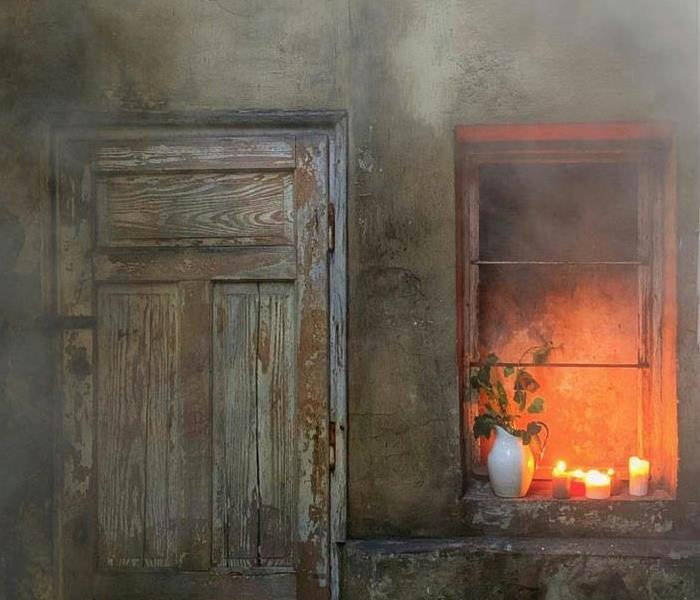 We make fire damage "Like It Never Even Happened”
We make fire damage "Like It Never Even Happened”
We restore Smoke and Soot Damage
7/28/2022
Smoke and soot is very invasive and can penetrate various cavities within your home or business, causing hidden damage and odor. Our smoke damage expertise and experience allows us to inspect and accurately assess the extent of the damage to develop a comprehensive plan of action.
Smoke and soot facts:
- Hot smoke migrates to cooler areas and upper levels of a structure.
- Smoke flows around plumbing systems, seeping through the holes used by pipes to go from floor to floor.
- The type of smoke may greatly affect the restoration process.
Different Types of Smoke
There are two different types of smoke–wet and dry. As a result, there are different types of soot residue after a fire. Before restoration begins, SERVPRO of Upper East Side will test the soot to determine which type of smoke damage occurred. The cleaning procedures will then be based on the information identified during pretesting. Here is some additional information:
Wet Smoke – Plastic and Rubber
- Low heat, smoldering, pungent odor, sticky, smeary. Smoke webs are more difficult to clean.
Dry Smoke – Paper and Wood
- Fast burning, high temperatures, heat rises therefore smoke rises.
Protein Fire Residue – Produced by evaporation of material rather than from a fire
- Virtually invisible, discolors paints and varnishes, extreme pungent odor.
Our Fire Damage Restoration Services
Since each smoke and fire damage situation is a little different, each one requires a unique solution tailored for the specific conditions. We have the equipment, expertise, and experience to restore your fire and smoke damage. We will also treat your family with empathy and respect and your property with care.
Have Questions about Fire, Smoke, or Soot Damage?
Call Us Today – SERVPRO of Upper East Side - 917-924-2260
Know When You're At Risk of a Dryer Fire
8/8/2022 (Permalink)
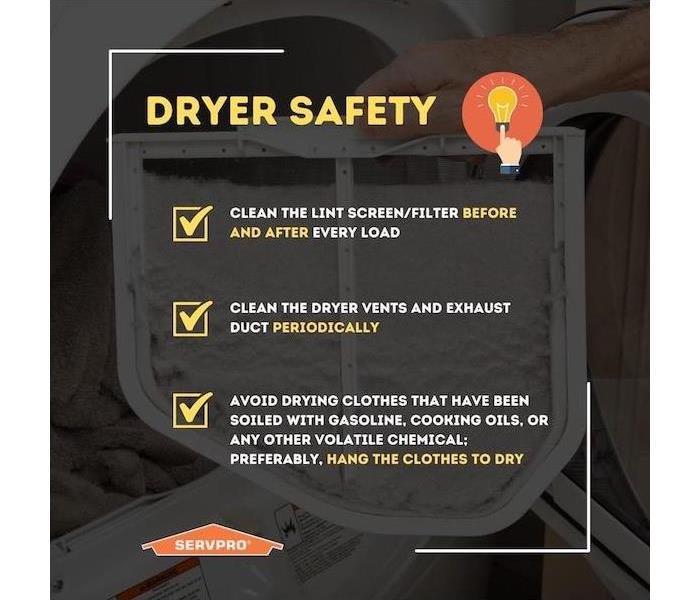 Dryer Safety Tips
Dryer Safety Tips
Clothes dryer fires are the leading cause of both Residential and Commercial fires. Dryer fires can happen when lint from your laundry builds up in the dryer or in the exhaust duct itself. When lint accumulates enough to block air flow, it causes heat to increase which results in a fire. According to The Consumer Product Safety Commission, more than 15,500 fires occur annually from clothes dryers. The U.S. Fire Administration reports the leading cause of these fires, is failure to clean the dryer vent.
How do you know when you're at risk of a dryer fire? Here is a list of warning signs..
- Outside of your dryer is very hot to the touch
- Your load of clothes are unusually hot
- You find the lint trapper filled with more lint than normal
- The laundry room is very hot and humid
- The exterior dryer vent has no air flowing out while the dryer is on
- The exterior vent has an accumulation of lint around it
- Drying time is taking longer than normal
- The vent hood flap doesn't open properly
- You notice a burning smell
- It's been longer than a year since you've had your dryer duct inspected
Things you can do between inspections to prevent a clogged dryer vent..
- Clean the lint screen after each cycle
- Vacuum the lint trap housing cavity once a month
- Clean behind and under the dryer
- Only run the dryer when you are home
- Inspect and fix and improper dryer ducting
- Do not dry clothes containing Volatile Organic Compounds. Some examples of VOC's are cooking oils, gasoline, cleaning agents, stains, etc.
- Have your dryer exhaust vents inspected and cleaned once a year
Call SERVPRO of Upper East Side to schedule your dryer vent inspection and cleaning today. (917) 924-2260
Create A Fire Escape Plan
8/6/2022 (Permalink)
 Have An Escape Plan
Have An Escape Plan
Keeping your family safe if there is a fire in your home, requires working smoke alarms and having an escape plan. If a smoke alarm sounds due to a fire, you and your family have as little as two minutes to escape. Once a fire starts, it spreads very rapidly. Every second counts! Every home should have a fire safety plan in place and all family members must practice the plan until everyone can escape in less than two minutes. Follow the steps below to create a plan for your family.
1. Create an escape plan
Get all your family members together and walk through every room in your home, while talking about ways to escape. You should try to aim for two escape routes from every room if possible. Make a drawing of your home mapping out ways to exit. If you have small children, make sure they are paying attention and understand the escape plan. Never open a closed door until you touch it first, if it's hot find another way to escape. Have everyone practice dropping to their tummy and crawling, to reduce smoke inhalation.
2. Pick a meeting place
Choose a place to meet when you are safely out of harms way. The meeting place should be far enough away from your home. Go over the chosen location with all family members.
3. Practice
It is not enough to have a fire safety plan and meeting place, you must also practice your plan as many times as it takes till everyone in your family can escape in less than two minutes. Practice leaving from different rooms, practice dropping to your stomach and practice testing to see if doors and door handles are hot. When you are safely outside and at your meeting place, call 911. Never go back inside! Practice this plan twice a year, you may want to practice more frequently if you have small children.
4. Test smoke alarms
A fire safety plan will not work if your smoke detectors are not working. Every smoke detector in your home must be fully operational at all times. Make a habit of testing each smoke alarm once a month.
We are available for you 24 hours a day, if you are in need of our services. 917-924-2260
Fire Safety Tips
8/6/2022 (Permalink)
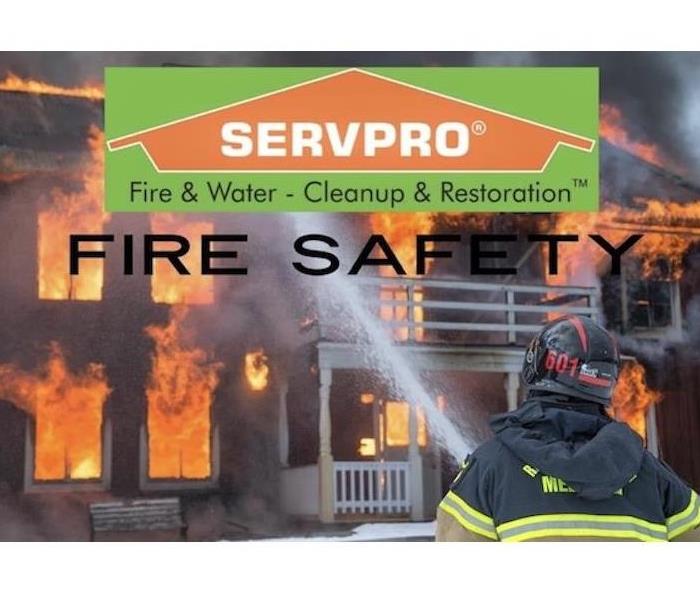 Fire Prevention Tips
Fire Prevention Tips
Install Smoke Detectors and Carbon Monoxide Alarms
- Top of the list in preventing house fires is by installing smoke detectors and carbon monoxide alarms in your home and remembering to test them at least twice a year. The US Fire Administration recommends changing the batteries twice a year and replacing the detectors and alarms every 10 years.
Purchase Fire Extinguishers
- A fire extinguisher should be in every kitchen, because the kitchen is one of the most common place where house fires start. You should also have one on hand in your bedroom.
- Be sure they are easily accessible and most important, make sure everyone in your family knows how to use one. Each member of your family should be taught how to operate a fire extinguisher. For young children, post P.A.S.S. acronym near each fire extinguisher.
Inspect Heating Equipment, Annually
- National Fire Protection Association (NFPA) say the leading cause of fires in US homes are caused by heating equipment (including space heaters, fireplaces and heating systems)
- Have your furnace inspected and a tune-up done annually. It will prolong the life of your furnace and it can prevent house fires.
- It's important to know when heating systems aren't working properly, they can release carbon monoxide. Carbon Monoxide is a colorless, odorless gas that can cause severe illness and death.
- It is also recommended that you install a Notion Sensor next to your Carbon Monoxide alarm. This will notify you when your Carbon Monoxide alarm goes off, giving time for you and your family and pets to evacuate safely.
Don't use frayed or cracked electrical cords.
- Pulling on a cord can wear it out over time – and cords that are worn or frayed can increase the risk of a short circuit, an electrical shock, and even a fire.
Don't leave the kitchen unattended when the stove or oven is on.
Extension Cords should never be used on the following items
- Do NOT use an extension cord with the following items: ice makers, refrigerators, microwaves, space heater, hair dryer, garbage disposals, air conditioners, toasters/toaster ovens, washers/dryers, and coffee/tea makers.
Never leave lit candles unattended
- If you use candles regularly, it’s so important to put them out before leaving the room.
- You should also keep them far away from any blankets, carpets, or other flammable objects.
- If you have small children or pets, it’s also a good idea to keep lit candles out of reach.
Store flammable liquids properly
- According to the NFPA, flammable or combustible liquids cause more than 43,000 home fires each year!
- It's so important to carefully read product labels, keep an eye out for any warnings, and store accordingly.
Have your dryer inspected by a professional at least once a year
- Dryers cause more than 20,000 house fires every year, causing millions of dollars in damage.
- Regular cleaning and maintenance are all you need to protect your family and your home from dryer fires.
- Removing the lint trap from your dryer after every use and clean it.
- Lint will also build up inside the dryer vent and ductwork, so it's best to call a professional at least once a year to have an inspection and cleaning.
Consider renters insurance if you rent an apartment
- Renters insurance covers your personal property if it is damaged or stolen, medical and legal bills if you are found liable for damaging someone's property or injuring them, and temporary living expenses if your rental home is uninhabitable.
Carbon Monoxide Safety
8/1/2022 (Permalink)
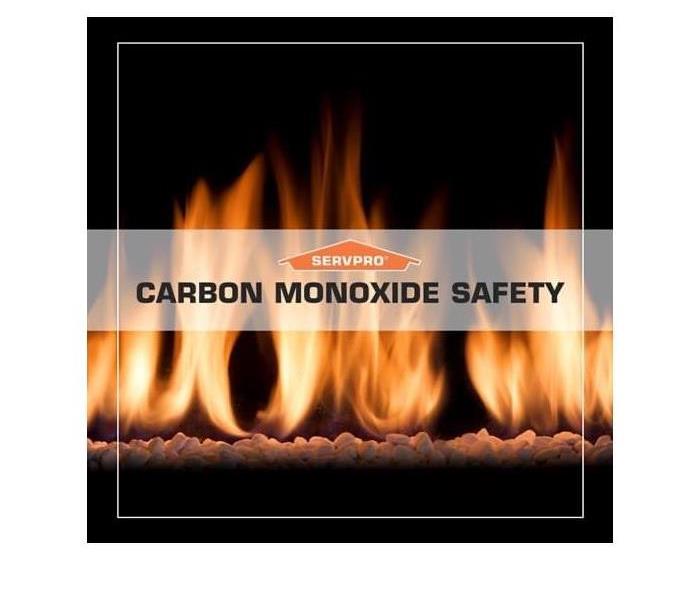 Carbon Monoxide Safety
Carbon Monoxide Safety
Carbon Monoxide is a colorless, tasteless and odorless gas.Carbon Monoxide is also known as The Silent Killer. It is a colorless, tasteless and odorless gas, that is deadly. It is undetectable by humans and pets. It is released into the air from burning fuel, so anything in your home or business that runs off fuel is a potential source. When the gas is released into poorly-ventilated enclosed space, carbon monoxide molecules replace the oxygen in the air. Poisoning occurs when the carbon monoxide accumulates to dangerous levels in your blood stream. High concentrations can kill in less than five minutes.
Some common sources of carbon monoxide poisoning:
- Gas Fired Furnaces/hot water heaters
- Wood burning stoves
- Gas ranges/ovens
- Space Heaters
- Generators
- Gas Grills
- Clogged Chimneys
- Heating exhaust vents
- House fires
- Running cars in enclosed spaces
- Using gas powered tools in enclosed spaces
Symptoms of carbon monoxide poisoning
- Flu-like symptoms
- Headache
- Confusion
- Dizziness
- Lightheadedness
- Shortness of breath
- Nausea
- Weakness
- Blurred Vision
- Chest pain
- Loss of consciousness
Carbon monoxide poisoning is preventable
- Purchase and install carbon monoxide detectors in the hallway near each bedroom
- Test them regularly, replacing batteries or detector when necessary
- Have everything that operates by fuel inspected once a year by a qualified professional
- Don't run your vehicle in an enclosed space
- Check the exhaust pipe of your vehicle to be sure it isn't blocked
- Never grill indoors
- Practice safe generator usage
If you suspect carbon monoxide poisoning, evacuate immediately and be sure to take all your pets with you. Leave the door open for ventilation and contact the fire department.
Here Is What You Should Do For Your Fire Damage Situation in Manhattan
4/30/2019 (Permalink)
 Don't let fire damage take over your home. Call SERVPRO today for fire damage restoration assistance.
Don't let fire damage take over your home. Call SERVPRO today for fire damage restoration assistance.
The Purpose of Pack-Outs for Your Fire-Damaged Manhattan Home
Protecting the belongings and items within your fire-damaged Manhattan apartment can be challenging, especially when the effects from the disaster can spread so quickly through the unit. Instead of fixating on the contents of your property that you can preserve and save when disaster strikes, it is advisable to get you and your family to safety first. Professional restoration technicians and cleaners can make the retrieval and restoration of damaged items, belongings, furniture, and fabrics within your apartment a priority of the mitigation process that happens alongside a thorough inspection and assessment of the property.
Pack-outs are a vital component to the mitigation work that our team can do for fire damage in your Manhattan apartment. We arrive with production trailers full of packing materials, boxes, blankets, and other protective gear to keep the contents removed from your property safe through the travel to our nearby facility. While much of the restoration work by our SERVPRO team can happen onsite, many individual contents require specialized attention, cleaning, and deodorization, that best occurs in our care.
Once your items and furniture arrive at our facility, we often work first to clean soot and smoke residue staining. We have multiple approaches to this focused cleaning effort; the ultrasonic cleaning tank is one of the more effective options for the contents that can get submerged in liquid safely. Once we have removed soot and smoke particulates from the items, we can shift focus to deodorization.
Again, there are multiple approaches to removing the harsh fire odors from the contents removed from your apartment. An ozone chamber can allow our SERVPRO recovery team to address multiple items and contents at once, introducing an environment with an added molecule of oxygen that can bond molecularly with the odor to neutralize it.
The pack-out process can save many of the at-risk or already damaged items and furniture throughout your apartment after a fire. Our SERVPRO of Upper East Side rapid response team has effective mitigation approaches that can save you money and protect your belongings until they can safely get returned to your restored property. Give us a call anytime at (917) 924-2260.
Click here for more information about the city of Manhattan.
We Have Fire Suppression Systems Waiting To Clean Up Your Upper East Side Fire Damage
4/25/2019 (Permalink)
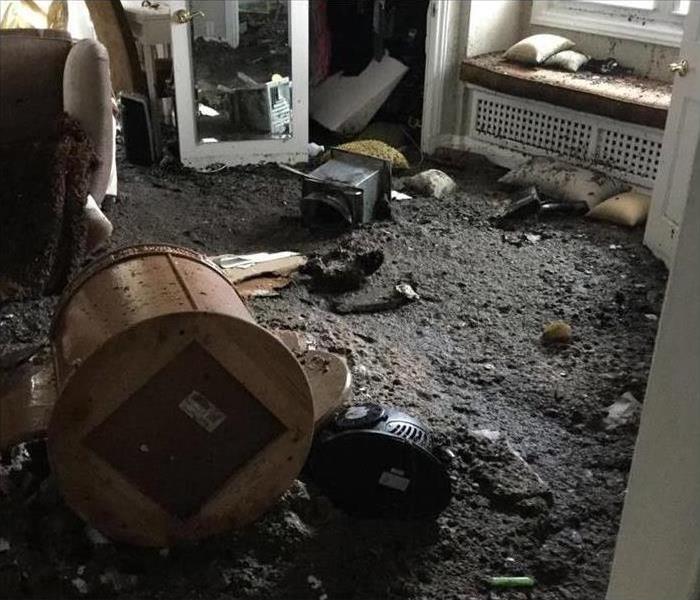 This fire was devastating and our team worked hard to get their home stabilized and cleaned up. Call us right away.
This fire was devastating and our team worked hard to get their home stabilized and cleaned up. Call us right away.
Cleaning Fire Suppressant Residue from Your Upper East Side Apartment
Fire suppression systems are vital to protecting not only your apartment on the Upper East Side but those connected to your residence as well. With so much at stake, suppression systems need to be thorough, direct, and often much more powerful than necessary to fully extinguish the flames. While the fast reaction of your system to respond to changing conditions like a fire can help to preserve and protect your property and your neighbors’, it can often leave quite a mess for professional restoration technicians like ours to address in the recovery and mitigation of your apartment.
While there are many varieties of fire suppression devices and systems to help reduce fire damage to your Upper East Side property, many of the modern renovations and new constructions feature dry powder suppressions. Some models have an intelligent response to emergencies, reacting only in the areas currently affected by the fire rather than causing all receivers to respond simultaneously like an apartment sprinkler system would. Our SERVPRO team can respond quickly, 24/7, to help address the effects of a dry powder suppression system on your apartment.
Our team can arrive with the full measure of cleaning equipment like high-powered vacuums to begin pulling up loose sediment and chemicals. We can work to clear off heavy concentrations on counters, walls, flooring, and other areas where the excess would collect. We also have personal protective equipment to keep our team safe throughout the cleanup process, as the ingesting or sometimes direct exposure to these dry chemicals can be a hazard.
The SERVPRO professionals that respond to the cleaning of fire damage in your property can also assess damages that could have occurred before the suppression engaged. We can remove damaged structural elements and construction materials with controlled demolition techniques, helping to ensure that reconstruction efforts and build back are quick and simple to begin.
For as vital of a role as dry chemical powder suppression systems have in protecting your property from fire, cleaning up after it can be a challenge. Let our SERVPRO of Upper East Side make the effects of fire damage and these extinguishing methods “Like it never even happened.” by calling (917) 924-2260.
Click here for more information about the different types of sight seeing you can discover in NYC.
Fire Extinguishers
9/14/2018 (Permalink)
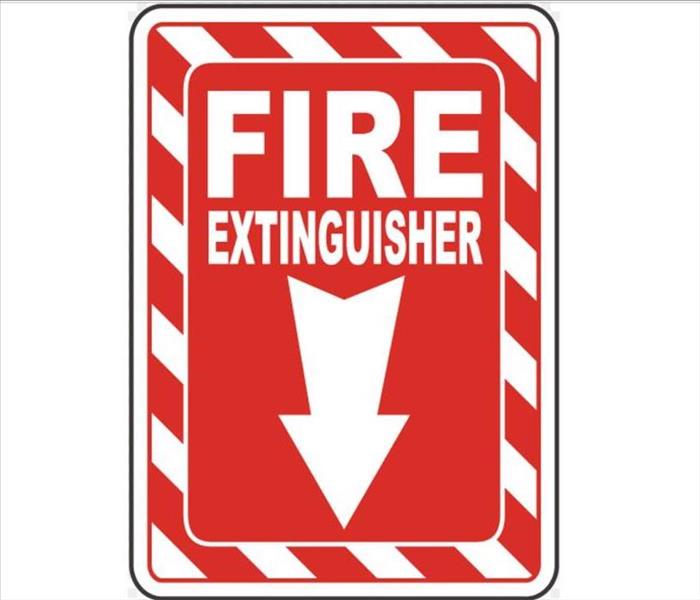 Never skipped out on having a fire sting wisher in your own home or business, They can save lives. No one is an exception.
Never skipped out on having a fire sting wisher in your own home or business, They can save lives. No one is an exception.
Fire Extinguishers
A portable fire extinguisher can save lives and property by putting out a small fire or containing it until the fire department arrives; but portable extinguishers have limitations. Because fire grows and spreads so rapidly, the #1 priority for residents is to get out safely.
Safety tips
- Use a portable fire extinguisher when the fire is confined to a small area, such as a wastebasket, and is not growing; everyone has exited the building; the fire department has been called or is being called; and the room is not filled with smoke.
- To operate a fire extinguisher, remember the word PASS:
- Pull the pin. Hold the extinguisher with the nozzle pointing away from you, and release the locking mechanism.
- Aim low. Point the extinguisher at the base of the fire.
- Squeeze the lever slowly and evenly.
- Sweep the nozzle from side-to-side.
- For the home, select a multi-purpose extinguisher (can be used on all types of home fires) that is large enough to put out a small fire, but not so heavy as to be difficult to handle.
- Choose a fire extinguisher that carries the label of an independent testing laboratory.
- Read the instructions that come with the fire extinguisher and become familiar with its parts and operation before a fire breaks out. Local fire departments or fire equipment distributors often offer hands-on fire extinguisher trainings.
- Install fire extinguishers close to an exit and keep your back to a clear exit when you use the device so you can make an easy escape if the fire cannot be controlled. If the room fills with smoke, leave immediately.
- Know when to go. Fire extinguishers are one element of a fire response plan, but the primary element is safe escape. Every household should have a home fire escape plan and working smoke alarms.

 24/7 Emergency Service
24/7 Emergency Service






